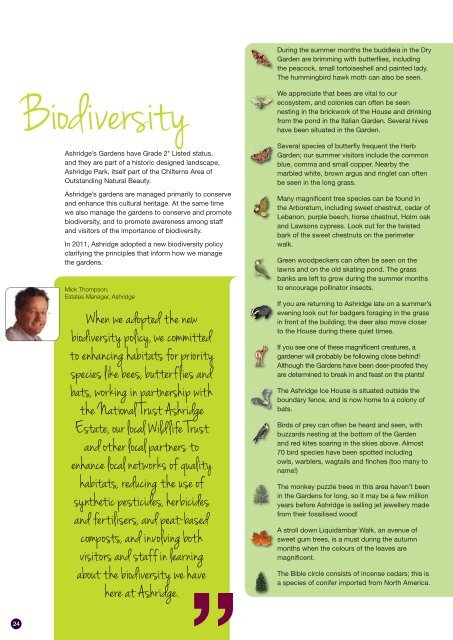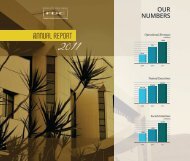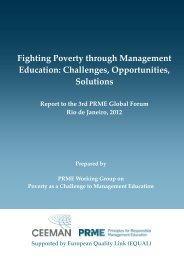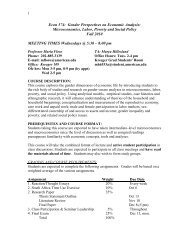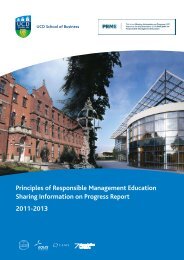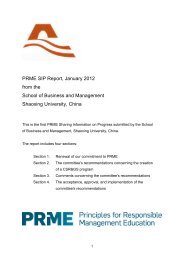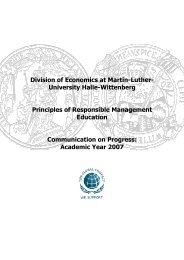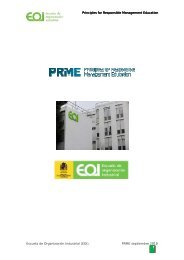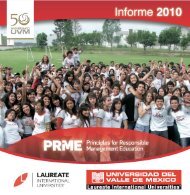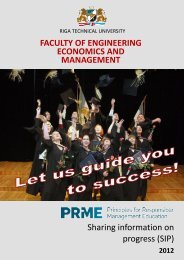Ashridge in a rapidly changing world develop sustain lop - PRME
Ashridge in a rapidly changing world develop sustain lop - PRME
Ashridge in a rapidly changing world develop sustain lop - PRME
Create successful ePaper yourself
Turn your PDF publications into a flip-book with our unique Google optimized e-Paper software.
Biodiversity<br />
<strong>Ashridge</strong>’s Gardens have Grade 2* Listed status,<br />
and they are part of a historic designed landscape,<br />
<strong>Ashridge</strong> Park, itself part of the Chilterns Area of<br />
Outstand<strong>in</strong>g Natural Beauty.<br />
<strong>Ashridge</strong>’s gardens are managed primarily to conserve<br />
and enhance this cultural heritage. At the same time<br />
we also manage the gardens to conserve and promote<br />
biodiversity, and to promote awareness among staff<br />
and visitors of the importance of biodiversity.<br />
In 2011, <strong>Ashridge</strong> adopted a new biodiversity policy<br />
clarify<strong>in</strong>g the pr<strong>in</strong>ciples that <strong>in</strong>form how we manage<br />
the gardens.<br />
Mick Thompson,<br />
Estates Manager, <strong>Ashridge</strong><br />
When we adopted the new<br />
biodiversity policy, we committed<br />
to enhanc<strong>in</strong>g habitats for priority<br />
species like bees, butterf lies and<br />
bats, work<strong>in</strong>g <strong>in</strong> partnership with<br />
the National Trust <strong>Ashridge</strong><br />
Estate, our local Wild life Trust<br />
and other local partners to<br />
enhance local networks of quality<br />
habitats, reduc<strong>in</strong>g the use of<br />
synthetic pesticides, herbicides<br />
and fertilisers, and peat-based<br />
composts, and <strong>in</strong>volv<strong>in</strong>g both<br />
visitors and staff <strong>in</strong> learn<strong>in</strong>g<br />
about the biodiversity we have<br />
here at <strong>Ashridge</strong>.<br />
Dur<strong>in</strong>g the summer months the buddleia <strong>in</strong> the Dry<br />
Garden are brimm<strong>in</strong>g with butterfl ies, <strong>in</strong>clud<strong>in</strong>g<br />
the peacock, small tortoiseshell and pa<strong>in</strong>ted lady.<br />
The humm<strong>in</strong>gbird hawk moth can also be seen.<br />
We appreciate that bees are vital to our<br />
ecosystem, and colonies can often be seen<br />
nest<strong>in</strong>g <strong>in</strong> the brickwork of the House and dr<strong>in</strong>k<strong>in</strong>g<br />
from the pond <strong>in</strong> the Italian Garden. Several hives<br />
have been situated <strong>in</strong> the Garden.<br />
Several species of butterfl y frequent the Herb<br />
Garden; our summer visitors <strong>in</strong>clude the common<br />
blue, comma and small copper. Nearby the<br />
marbled white, brown argus and r<strong>in</strong>glet can often<br />
be seen <strong>in</strong> the long grass.<br />
Many magnifi cent tree species can be found <strong>in</strong><br />
the Arboretum, <strong>in</strong>clud<strong>in</strong>g sweet chestnut, cedar of<br />
Lebanon, purple beech, horse chestnut, Holm oak<br />
and Lawsons cypress. Look out for the twisted<br />
bark of the sweet chestnuts on the perimeter<br />
walk.<br />
Green woodpeckers can often be seen on the<br />
lawns and on the old skat<strong>in</strong>g pond. The grass<br />
banks are left to grow dur<strong>in</strong>g the summer months<br />
to encourage poll<strong>in</strong>ator <strong>in</strong>sects.<br />
If you are return<strong>in</strong>g to <strong>Ashridge</strong> late on a summer’s<br />
even<strong>in</strong>g look out for badgers forag<strong>in</strong>g <strong>in</strong> the grass<br />
<strong>in</strong> front of the build<strong>in</strong>g; the deer also move closer<br />
to the House dur<strong>in</strong>g these quiet times.<br />
If you see one of these magnifi cent creatures, a<br />
gardener will probably be follow<strong>in</strong>g close beh<strong>in</strong>d!<br />
Although the Gardens have been deer-proofed they<br />
are determ<strong>in</strong>ed to break <strong>in</strong> and feast on the plants!<br />
The <strong>Ashridge</strong> Ice House is situated outside the<br />
boundary fence, and is now home to a colony of<br />
bats.<br />
Birds of prey can often be heard and seen, with<br />
buzzards nest<strong>in</strong>g at the bottom of the Garden<br />
and red kites soar<strong>in</strong>g <strong>in</strong> the skies above. Almost<br />
70 bird species have been spotted <strong>in</strong>clud<strong>in</strong>g<br />
owls, warblers, wagtails and fi nches (too many to<br />
name!)<br />
The monkey puzzle trees <strong>in</strong> this area haven’t been<br />
<strong>in</strong> the Gardens for long, so it may be a few million<br />
years before <strong>Ashridge</strong> is sell<strong>in</strong>g jet jewellery made<br />
from their fossilised wood!<br />
A stroll down Liquidambar Walk, an avenue of<br />
sweet gum trees, is a must dur<strong>in</strong>g the autumn<br />
months when the colours of the leaves are<br />
magnifi cent.<br />
The Bible circle consists of <strong>in</strong>cense cedars; this is<br />
a species of conifer imported from North America.<br />
24 www.ashridge.org.uk 25


